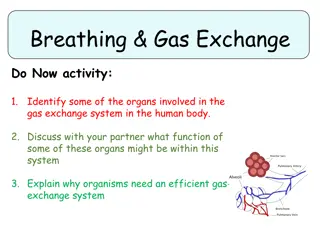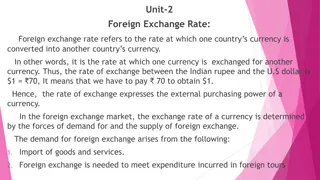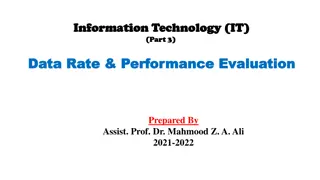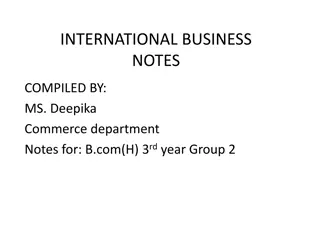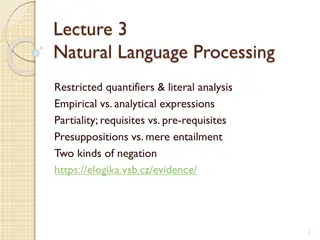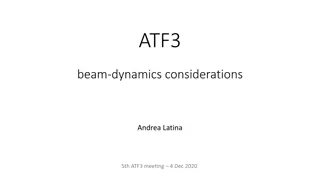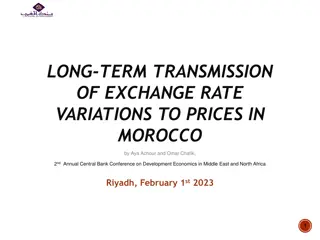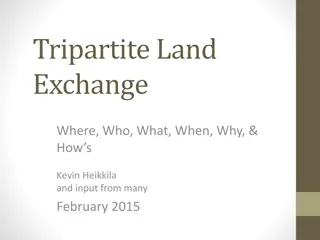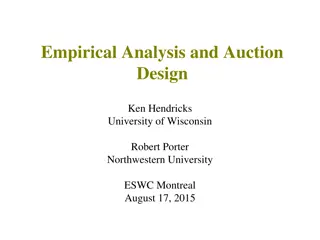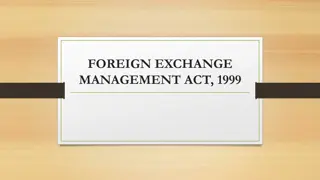Empirical Analysis of Kuwaiti Dinar Exchange Rate Behavior and Misalignment
This research focuses on studying the behavior of the real equilibrium exchange rate (REER) of Kuwaiti Dinars, estimating the equilibrium exchange rate using the BEER model, and calculating real exchange misalignments (RERM). It delves into the impact of exchange rate fluctuations on macroeconomic variables such as GDP, trade, interest rates, unemployment, and inflation. The importance of RER misalignments is highlighted, as they can predict future shifts in exchange rates, potentially signaling financial crises or the need for exchange rate adjustments. The study's empirical approach draws from existing literature on the relationship between real exchange rates and economic fundamentals in various countries.
Download Presentation

Please find below an Image/Link to download the presentation.
The content on the website is provided AS IS for your information and personal use only. It may not be sold, licensed, or shared on other websites without obtaining consent from the author. Download presentation by click this link. If you encounter any issues during the download, it is possible that the publisher has removed the file from their server.
E N D
Presentation Transcript
Behaviour equilibrium exchange rate and misalignment: Empirical Case from Kuwaiti Dinars Researchers: Zainab Alhayki (Ahlia University) Ahmed Alhayky (Skyline University)
Outline of Presentation I. Introduction II. Aim, Motivation and Contribution III.Literature Review IV.Econometric Methodology and Data V. Processing the Results VI.Conclusions
I. Introduction Exchange rate plays a significant role to achieve both internal and external balance. Exchange rate fluctuation affect macroeconomics variables: Level of GDP Trade Interest rate Unemployment Inflation
Importance of RER Misalignments Could be used to predict future shifts of the exchange rate (Aguirre, Calderon, (2005)). A likely prelude to financial crisis (Krugman (1979), Kaminsky and Reinhart (1999)); May underline the need to adjust the exchange rate; May affect economic growth (Edwards (1989)); May boost the economic growth, as was the case of Japan and Germany and more recently, China (Dooley et al. (2003)).
II. Aim and Motivation Aim: Choosing the variables that determine the behavior of the real equilibrium exchange rate (REER) Estimating the equilibrium exchange rate (the BEER model) Calculating the real exchange misalignments (RERM)
III. Literature Review The relationship between real exchange rates and economic fundamentals (trade openness, productivity as well as terms of trade) was the scope of a study done by Yehoue and Dufrenot in 2005. Their sample includes 64 developing countries. They found that exchange rate dynamics of low-income countries are more likely to be explained by economic fundamentals than they are for middle-income countries. In 2007, Ghana s behavioral equilibrium exchange rate (BEER) was assessed by Iossifov and Loukoianova. They found that Ghana's main export commodities real world prices, real GDP growth as well as real interest rate differentials (both relative to trading-partner countries) can explain REER's long-run behavior. Based on that, they found that in 2006 REER was close to its estimated equilibrium level and that within two to three years the deviations from the equilibrium path will be eliminated. Sallenave (2010) measured the growth impact of REER misalignments for the G20 countries. He found that developed countries converge slowly towards its estimated equilibrium exchange rate while size of misalignment for the emerging countries is higher than industrialized ones. Moreover, he found that economic growth is negatively influenced by misalignments. .
III. Methodology and Data Unit Root Test To check stationary problems Co-integration Tests To examine the long run co-integration relationship among variables ARDL Model To estimate the long run equilibrium level of the REER
III. Methodology and Data Variables Oil Price (OIL) Monetary Policy Proxy (MP) Relative productivity (PROD) Net Capital Flow (NKF) Degree of Openness (OPN) Government Expenditures (GOV) Reserve to GDP (RES) Data source Bloomberg Sample from1985Q1 to 2013Q4
Unit Root Test: (Level) ADF- Test Phillips-Perron Test Constant & Trend Constant & Trend Variables None Constant Decision None Constant Decision LRER 0.84 -0.99 -1.61 I(1) 0.82 -0.86 -1.52 I(1) LGOV -0.44 -1.67 -1.96 I(1) -0.80 -2.34 -2.19 I(1) LMP -0.24 -1.74 -2.86 I(1) -0.41 -2.82*** -3.03 I(1) LOIL 0.03 -2.02 -2.38 I(1) -0.01 -1.41 -1.98 I(1) LOPN -1.6*** -3.76* -4.15* I(0) -2.25** -3.82** -3.93** I(0) LPRO -0.74 -1.94 -2.69 I(1) -0.84 -2.16 -2.50 I(1) LRES 0.84 -0.99 -1.61 I(1) 0.82 -0.86 -1.52 I(1) NKF -1.8*** -3.33** -3.84** I(0) -2.07** -3.16** -3.53** I(0)
Unit Root Test: (1st Difference) ADF- Test Phillips-Perron Test Constant & Trend Constant & Trend Variables None Constant Decision None Constant Decision DLRER -7.63* -7.67* -7.69* I(0) -7.57* -7.60* -7.70* I(0) DLGOV -5.25* -5.22* -5.46* I(0) -3.55** -3.35* -3.51** I(0) DLMP -5.94* -5.90* -6.43* I(0) -4.48* -4.46* -4.52* I(0) DLOIL -7.64* -7.60* -6.18* I(0) -7.02* -6.96* -6.80* I(0) DLOPN -10.45* -10.41* -10.36* I(0) -13.11* -13.67* -13.10* I(0) DLPRO -5.69* -5.50* -5.69* I(0) -5.53* -5.56* -5.69* I(0) DLRES -4.40* -4.38* -4.37* I(0) -10.12* -10.06* -10.21* I(0) DNKF -8.45* -8.42* -8.50* I(0) -6.79* -6.73* -11.75* I(0)
Co-integration test results: Table 4.2: Results of Co-integration test associated with Diagnostic statistics Serial Correlation F-statistic* ECM (-1) T-Statistic Functional Form Heteroscedasticity 6.641 -0.1135 -3.875 12.481 1.23 2.181 * The asymptotic upper bound critical value for F-statistics at 1% level of significance is 4.43.
Results of Long- and short-run analysis: Table 4.3: Results of Estimated long-run and short-run Coefficients Estimated Long-run Variables LGOV LMP LOIL LOPN -0.45 (-2.41)** DLOIL Estimated Short-run Coefficients 1 0.45 (4.88)* 0.00 (-0.07) 0.01 (-0.18) 0.14 (-1.65) -0.32 (-1.61) 0.00 (0.00) -0.02 (-1.34) Coefficients 0.38 (2.32)** 0.57 (2.59)** 0.26 (3.85)* Variables DLRER DLGOV DLMP 0 2 3 0.16 (1.72)*** -0.05 (-1.53) 0.32 (3.52)* 0.02 (1.90)*** (- 1.80)*** 0.17 (2.08)** -0.20 (-3.00)* LPRO 1.41 (4.16)* DLOPN -0.02 (-1.29) -0.01 (-0.64) -0.02 -0.03 (-2.14)** LRES C 0.03 (0.77) 11.83 (6.30) DLPRO DLRES -0.67 (-11.93)* 0.00 (0.70) 0.32 (2.10)** Note: *, ** and *** denote significance at the 1%, 5% and 10% levels, respectively. Parentheses are t-statistics.
Behavioral Equilibrium Exchange Rate and Misalignment Figure 4.1: Interaction between LRER, BEER, PEER Figure 4.2: RER Misalignment 4.9 3 4.8 2 4.7 1 4.6 0 4.5 -1 4.4 -2 86 88 90 92 94 96 98 00 02 04 06 08 10 12 86 88 90 92 94 96 98 00 02 04 06 08 10 12 LRER BEER PEER
III. Conclusion The independent variables play a significant role in determining REER both in long and short run. The degree of misalignment ranged between -1.382 to 2.184 percent with zero reversion mean. The overvaluation periods were during (1986- 90, 1996-98, 2002, 2005-08 and 2012-13) and the undervaluation periods were during (1991-95, 1999- 01, 2003-04 and 2009-011). The misalignment getting smaller and smaller.






